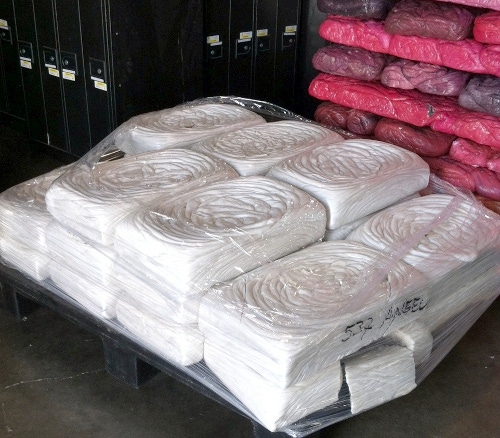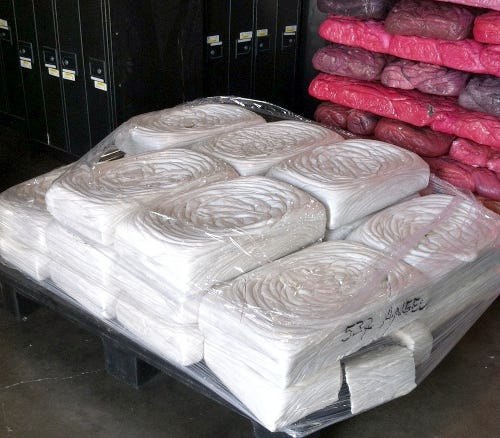January 30, 2014


Densified EPS on pallet
Ban this, ban that...it seems plastics continue to take the brunt of recent activism to eliminate certain types of end-use applications from the planet. Bans seem to gain momentum when there is no viable existing solution that addresses what the advisories are attempting to eliminate.
One could present a case that many of these bans would not occur if viable solutions existed. For example, the problem that initiated bans on plastic bottles would probably go away if recycle drop-off containers were present everywhere to more easily facilitate their recovery and collection, if the local recycle infrastructure would and could accept all plastic containers, if economically viable markets existed for recycled plastics and if consumers were not totally confused on the simple steps of how and what to recycle.
Let's take the real case of expanded polystyrene foam (EPS), commonly referred to as Styrofoam. EPS used in packaging is an engineered solution to solve many packaging transport, safety and protection problems. EPS is a lightweight material, about 95 to 98 percent air, with good insulation properties. It is used in all types of products from drink cups that keep beverages hot or cold to packaging material. Its lightweight properties save fuel during shipping, protect goods from breakage and are low cost.
While the technology for recycling EPS is available, the bulkiness and lightweight nature of this packaging material is a hindrance to the recovery/recycle process. What if this problem could be addressed? Another area that needs to be addressed is that many recyclers and municipalities do not pick up EPS or any plastic except those that have the number 1 (PET) or 2 (HDPE) in the symbol with the chasing arrows on the plastic article. What if this, too, could be eliminated as a deterrent to EPS recovery/recycle?
There is significant demand for recycled EPS materials both in the U.S. and offshore, especially China. However, only a low 71 million pounds of EPS were recycled in 2010. The February 2013 Moore Recycling Associates Inc. Plastic Recycling Collection National Reach Study: 2012 Update found that 31.1 percent of the U.S. population has access to recycling programs for EPS foam foodservice articles and 12.2 percent has access to recycling of EPS packaging shapes. Both of these numbers are low when compared to 94.2 percent for HDPE bottles/jugs and jars with caps and 94.0 percent for PET bottles/jugs and jars with caps.
Because of this limited access to EPS recycling, some businesses have a difficult time finding recycled EPS materials for their own raw materials. Recycled EPS foam has three potential uses: (1) mostly post-industrial in-house scrap and waste recycle put back into the process to combine with virgin EPS foam and (2) post-consumer recycled EPS to combine with virgin EPS or (3) used for non-EPS applications as an addition in virgin polystyrene and HIPS resin applications.
Independent research by Wilson Jene Consulting, Pittsburgh, PA, explored finding potential sources of recycled EPS materials for consumption in the U.S. for the third use cited above. The U.S. market for PS resin is significantly larger (roughly a factor of 10 times larger) than the EPS foam market. Surprisingly, sources of recycled EPS are limited. The research found that although many EPS molders collect and use recycled EPS in their processes, the number of recyclers selling these types of materials is somewhat limited and many purchasers of these materials are located overseas. Holly Wilson-Jene says, "Knowing there are many non-foam plastic processors around the country that could utilize recycled EPS as a feedstock, these findings indicate that the demand might in fact be there if more of this material was available." This sounds like a chicken and egg analogy. Wilson-Jene cites several reasons this material is in such high demand:
Recycled EPS is lower cost compared to virgin PS and is generally a high-quality feedstock with good physical properties.
Because raw material costs can often represent 50 to 70 percent of the total cost of the manufactured product, the availability of a lower cost feedstock can enable manufacturers to be competitive in specific applications and markets.
For some competitive markets and applications, the availability of a lower cost feedstock can help keep manufacturing located in the U.S.
So what is preventing this demand from being used? One of the reasons goes back to the earlier mentioned-EPS foam is 95 to 98 percent air. One cannot economically transport bulky foam from location A to location B. Or can one?
The solution is a process called densification, which can make EPS foam 50 to 90 times denser. Whereas a full 53-ft trailer load of loosely stacked EPS foam usually weighs approximately 2,000 pounds, compacted EPS foam that has been processed through a densifier can be shipped as a regular 40,000 lb full truck load (T/L) shipment.
Densification equipment can pay for itself often under two years in two ways:
1. Significant savings from reduced trash collection costs and landfill tipping costs; and
2. Revenue generated from the sale of the densified material and its further conversion for injection molding or extrusion processes.
The big question remains: How can this demand for recycled EPS be filled? Over the last 20 years or so, significant advances in densification equipment and the installation of many units across the U.S. has occurred. Some units even run on the more accessible 120 volt AC current vs 240 volt current. A list of suppliers can be found at www.packagingdigest.com/densifiers.
Small mobile densification units have been fabricated by enterprising recyclers, utilizing existing smaller EPS densification equipment which is then mounted on a truck and accompanied by a power generation unit. This grass roots approach will gain momentum as densification equipment manufacturers pursue this opportunity and overcome the equipment challenges and support grows for local recycling drives or other types of innovative recycling activity.
Some municipalities have used grants to install equipment that then generates a revenue stream for that municipality. Densification equipment is needed close to the source "locally" because of the lightweight nature of EPS foam and the high cost of transporting lightweight bulky materials. The densification process can be performed by the company generating the demand or through third party recyclers. The EPS foam recycling infrastructure is the "egg" in the previous analogy and EPS foam demand is the "chicken." Which comes first?
Brand owners and retailers with significant EPS packaging materials should reconsider the possibilities as they face challenges of developing more sustainable operations and zero waste programs. Gut feelings suggest that consumers would embrace the ability to recycle EPS foam if there were readily available recycle outlets. And with a typical payback of two years or less for equipment, recycling EPS often makes financial sense.
One way brand owners and retailers can accomplish this is by working together where retail stores are clustered together in a concise geographical area such as a mall complex to recycle waste EPS packaging materials. This could be accomplished by a recycling alliance, which would identify a site location within the area for a densifier operation managed by a recycler or brand owner. A second opportunity is for municipal recycling centers to develop an EPS recycling program using funding through grants and identifying marketplace demand for the recycled materials.
There are possibilities galore if we used our (recycled) resources more efficiently. There is a wave of change occurring in the plastic recycling market place. For example, non-bottle clear rigid plastic containers, plastic films/bags and larger non-packaging plastic parts are being added to recycle streams daily. Maybe now is the time to creatively identify more opportunities where recycled EPS can be added to this changing marketplace.
Jeff Timm is a Plastic Packaging & Adhesive Business Development Consultant, specializing in bioplastics and understanding of the cradle-to-cradle value chain to achieve sustainability goals. He is a frequent contributor to plastic and packaging journals as well as the bi-monthly Packaging Blog for www.adhesives.org, the web portal for the Adhesive & Sealant Council (ASC). He can be reached at Timm Consulting [email protected], www.linkedin.com/in/jefftimm, www.twitter.com/bioplasticman.
Moore Recycling Associates Inc., 707-935-3390
www.moorerecycling.com
Wilson Jene Consulting LLC, 412-513-9142
www.wilsonjeneconsulting.com
.
About the Author(s)
You May Also Like


